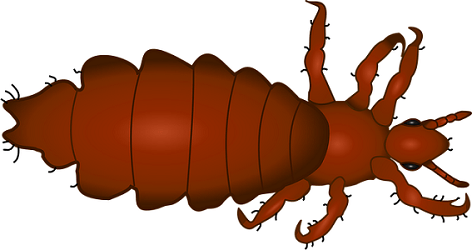I want to share about how to treat goats for lice, because goats are often infested with lice, which causes itching and discomfort. Lice are tiny insects that live in hair follicles. They feed by sucking blood from the host animal. The most effective way to prevent lice is to keep your goats free of fleas.
Lices are almost always present in every goat. If you notice any signs of lice in your goats, such as red bumps, scabs, or bald spots, contact your veterinarian immediately. You should also check your goats’ ears regularly. Look for small white dots, which are louse eggs. These will appear as tiny specks inside the ear canal.
This louse sucks goat’s blood. This can make goats feel itchy, anxious, scratching, stress goats, appetite down, goats become thin and susceptible to disease.
There are two types of ticks that usually goat on goats:
Biting lice

The head of the biting bug is large in size. They have a mouth section adapted to chewing structures that are part of their diet such as hair, feathers, skin droppings, scabs, wax wool, and even their own eggs.
They do not really bite but some species are known to suck tissue fluid from their host. This species lives on goats that have bacterial colonies in their digestive system cells that help them digest fur keratin.
Bite-type bugs, such as species that occur in goats and sheep, are thought to damage the hair by eating into the root part almost like tree felling.
These ticks prefer to stay at the base of the tail, between the legs, on the shoulders, head, neck and along the back, but can appear anywhere on the goat’s body.
Sucking lice

Lice that are sucked are part of an insect class called Anoplura. There are about 300 species and they are only known as mammalian parasites.
Linognathus stenopsis is a species found in goats. This suck type of lice has a tapered head. The part on its mouth will be pulled to the head when it is not used to suck blood from its host.
Unlike type of biting louse, some species of sucking louse are known able to transmit the disease. When the lice penetrate the skin, the saliva will be injected into the wound. As a result, it can prevent blood from clotting. In other words, the blood will be more fluid and difficult to stop even in very small amounts.
The reaction to this lice’s saliva can cause severe irritation. The signs that often found in goats are goats will bite, scratch, anxiety, insomnia and appetite disorders.
If the population is very large, this lice can also cause anemia. This can happen because the goat will lose a lot of blood.
This lice will eat continuously. As a result, the blood will much go out to the surface of goat skin because the blood is hard to freeze. Blood becomes more fluid as described above.
Then, the blood will dry on the surface of goat skin. This can attract the attention of flies. If left unchecked, it can cause an infection that becomes even worse.
Life cycle of goat lice
The entire life cycle of goat lice is done on the surface of the host’s skin. From egg to adult, the process occurs on goat or sheep skin.
Transmission of lice is only through direct body contact.
The female louse will attach its egg to the hair shaft with a glue-like substance. Then, nymphs hatch from eggs within a period of 1-2 weeks.
A week later, the first nymph will morpheme into the second nymph, then the third nymph until it becomes mature and reproduces again.
The egg cycle to adult lasts for 4-6 weeks depending on the species of lice.
Lice will die in a short time if they fall from the body of the host or body of the goat.
Lice eggs can not hatch at all if they fall from the body of the host or body of the goat.
Skin temperature is an important factor in hatching eggs. Higher temperatures prevent eggs from developing.
This suggests that the lice population is higher in winter than in summer.
Choose an Effective Treatment
There are several different treatments available for treating lice. Most veterinarians recommend using one of these methods:
1) Shampoo treatment: This involves applying a shampoo solution directly into the animal’s hair. It works by washing away the lice and nits (louse eggs).
2) Medicated shampoos: These contain insecticides that kill the lice and nymphs. They’re usually applied once a week for three weeks.
3) Combination treatments: These combine both shampoo and medicated shampoos.
There are many products available on the market that can kill lice. Eggs are not affected by lice medicine. So, the treatment should be repeated within a period of 10 to 14 days.
The goal is to kill nymphs before they grow into adulthood. The best time to treat lice is during the summer months when the population of goat lice is low.
One alternative medicine to overcome goat louse is an 8% solution of Annona squamosa or A. Muricata seed and mixture of 0.5 kg of neem leaves (Melia azadirachta L), 1 kg of tobacco leaves, 0.5 kg of A. squamosa seeds with 0 , 5 liters of water.
Prevention should be done regularly so that the goat louse does not come back again. Bathe regularly, Check periodically, Soak livestock or spray with cyper killer solution. But be careful not to be swallowed by the goat.
In addition, treatment can also use camphor. The trick, puree mothballs and sprinkle on goat skin.
And do not forget to spray the cage with anti-lice regularly. If the difficulty in the above way, can use this one way:
Bathe with enough laundry soap. Can use rinso, soklin or the other. Then add fastac (insectisida) 1/2 bottle cap per 5 liters of water. Avoid areas of eyes and mouth, drying goat which has been bathed to dry.
Mostly, Lice drugs contain the active ingredient is permethrin. Apparently, the use of permethrin is indeed for antiparasitic treatment.
But there is a source that mentions like this.
Permethrin is an insecticide in the pyrethroid family. Pyrethroids are synthetic chemicals that act like natural extracts from the chrysanthemum flower.
Permethrin is an artificial (synthetic) chemical. However, there are similar ingredients such as chrysanthemum plant extract.
The key is in chrysanthemum. Ornamental plants that are sold in many flower shops. The possibility of this flower can be used to treat goat lice.
But the application will be very difficult. Existing research also shows less serious results. An alternative to chrysanthemums is shallots. Because onions contain flavonoid compounds.
As for flavonoids, all spices contain that ingredient. For example, clove oil, essential oil. But it’s expensive.
Thats about how to treat goats for lice, please share if you like it. thank you.
 JOYNIM FARM Goat Farming, Cattle Farm, Laying Hens, Quail Farm, Gardening
JOYNIM FARM Goat Farming, Cattle Farm, Laying Hens, Quail Farm, Gardening



